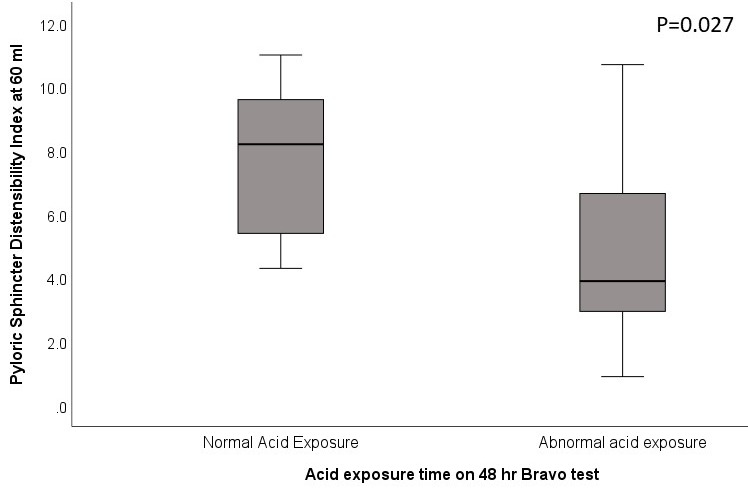Tuesday Poster Session
Category: Esophagus
P3255 - Examining the Correlation Between Gastroesophageal Sphincter Distensibility Measured by EndoFLIP and Esophageal Acid Exposure
Tuesday, October 24, 2023
10:30 AM - 4:00 PM PT
Location: Exhibit Hall

Has Audio

Shiab Mussad, MD
The Ohio State Wexner Medical Center
Columbus, OH
Presenting Author(s)
Shiab Mussad, MD1, Richard Maradiaga, MD2, Ladan Navari, BS3, Lauren Kanzaki, MS4, Yongkang Zhang, MD2, Subhankar Chakraborty, MD, PhD4
1The Ohio State Wexner Medical Center, Columbus, OH; 2Ohio State University Wexner Medical Center, Columbus, OH; 3The Ohio State University College of Medicine, Columbus, OH; 4The Ohio State University, Columbus, OH
Introduction: EndoFLIP is a novel technology to assess the distensibility of sphincters. Its role in understanding the pathophysiology of GERD is still being explored. The aim of our research was to investigate whether the distensibility of the pyloric, lower esophageal (LES) and upper esophageal sphincter (UES) correlates with the magnitude of acid reflux measured by the Bravo pH test.
Methods: This was a retrospective analysis of patients who underwent EndoFLIP test during sedated upper endoscopy along with Bravo pH test for evaluation of gastric or esophageal symptoms. Using the EF-322 catheter, we first assessed pyloric sphincter distensibility, then proceeded to assess the lower esophageal and finally the upper esophageal sphincter distensibility. The Bravo capsule was placed after completion of FLIP. Statistical analysis was carried out using IBM SPSS. Continuous variables were expressed as mean and standard deviation. ANOVA test was used to investigate differences in sphincter distensibility index (DI) between patients with normal and abnormal Bravo test. Spearman's correlation was used to assess relationship between continuous variables and chi-square test for categorical variables.
Results: Thirty-six patients were included, 92% were white and 69% females. Majority (78%) had an abnormal BRAVO test (acid exposure time or AET>4%). There was no difference in age or BMI between those with normal and abnormal AET. Pyloric DI at 60 ml was significantly smaller in those with abnormal AET (p=0.027, Figure 1). There was a weak negative correlation between acid exposure time and LES and pyloric DI at 40, 50 and 60 ml (Table 1). There was also a significant positive correlation between LES and pyloric DI at 30 ml (0.58, p=0.002) and borderline significant correlation between LES and pyloric DIs at 40 ml (0.38, p=0.05) and 50 ml (0.34, p=0.09). Pyloric DI at 50 ml was significantly smaller in those who complained of heartburn and nausea (4.8 vs. 8.0, p=0.047). LES DI at 50 and 60 ml were significantly greater in those who complained of globus (DI at 50 ml 2.6 vs. 1.1, p< 0.001, DI at 60 ml 3.6 vs. 1.6, p=0.004). There was no correlation between UES DI and AET, symptoms or with LES or pyloric DI.
Discussion: A tight pyloric sphincter may be responsible for heartburn and nausea in some patients. The correlation between Pyloric and LES DIs suggests that a common mechanism may be affecting distensibility of both sphincters. A greater LES DI may cause reflux which in turn may give rise to globus sensation.

Disclosures:
Shiab Mussad, MD1, Richard Maradiaga, MD2, Ladan Navari, BS3, Lauren Kanzaki, MS4, Yongkang Zhang, MD2, Subhankar Chakraborty, MD, PhD4. P3255 - Examining the Correlation Between Gastroesophageal Sphincter Distensibility Measured by EndoFLIP and Esophageal Acid Exposure, ACG 2023 Annual Scientific Meeting Abstracts. Vancouver, BC, Canada: American College of Gastroenterology.
1The Ohio State Wexner Medical Center, Columbus, OH; 2Ohio State University Wexner Medical Center, Columbus, OH; 3The Ohio State University College of Medicine, Columbus, OH; 4The Ohio State University, Columbus, OH
Introduction: EndoFLIP is a novel technology to assess the distensibility of sphincters. Its role in understanding the pathophysiology of GERD is still being explored. The aim of our research was to investigate whether the distensibility of the pyloric, lower esophageal (LES) and upper esophageal sphincter (UES) correlates with the magnitude of acid reflux measured by the Bravo pH test.
Methods: This was a retrospective analysis of patients who underwent EndoFLIP test during sedated upper endoscopy along with Bravo pH test for evaluation of gastric or esophageal symptoms. Using the EF-322 catheter, we first assessed pyloric sphincter distensibility, then proceeded to assess the lower esophageal and finally the upper esophageal sphincter distensibility. The Bravo capsule was placed after completion of FLIP. Statistical analysis was carried out using IBM SPSS. Continuous variables were expressed as mean and standard deviation. ANOVA test was used to investigate differences in sphincter distensibility index (DI) between patients with normal and abnormal Bravo test. Spearman's correlation was used to assess relationship between continuous variables and chi-square test for categorical variables.
Results: Thirty-six patients were included, 92% were white and 69% females. Majority (78%) had an abnormal BRAVO test (acid exposure time or AET>4%). There was no difference in age or BMI between those with normal and abnormal AET. Pyloric DI at 60 ml was significantly smaller in those with abnormal AET (p=0.027, Figure 1). There was a weak negative correlation between acid exposure time and LES and pyloric DI at 40, 50 and 60 ml (Table 1). There was also a significant positive correlation between LES and pyloric DI at 30 ml (0.58, p=0.002) and borderline significant correlation between LES and pyloric DIs at 40 ml (0.38, p=0.05) and 50 ml (0.34, p=0.09). Pyloric DI at 50 ml was significantly smaller in those who complained of heartburn and nausea (4.8 vs. 8.0, p=0.047). LES DI at 50 and 60 ml were significantly greater in those who complained of globus (DI at 50 ml 2.6 vs. 1.1, p< 0.001, DI at 60 ml 3.6 vs. 1.6, p=0.004). There was no correlation between UES DI and AET, symptoms or with LES or pyloric DI.
Discussion: A tight pyloric sphincter may be responsible for heartburn and nausea in some patients. The correlation between Pyloric and LES DIs suggests that a common mechanism may be affecting distensibility of both sphincters. A greater LES DI may cause reflux which in turn may give rise to globus sensation.

Figure: Figure 1. Box plot showing pyloric distensibility in patients with normal acid exposure time (<4%) or abnormal acid exposure time (>4%). P-value is for ANOVA test
Disclosures:
Shiab Mussad indicated no relevant financial relationships.
Richard Maradiaga indicated no relevant financial relationships.
Ladan Navari indicated no relevant financial relationships.
Lauren Kanzaki indicated no relevant financial relationships.
Yongkang Zhang indicated no relevant financial relationships.
Subhankar Chakraborty: Coloplast – Consultant. Medtronic – Consultant.
Shiab Mussad, MD1, Richard Maradiaga, MD2, Ladan Navari, BS3, Lauren Kanzaki, MS4, Yongkang Zhang, MD2, Subhankar Chakraborty, MD, PhD4. P3255 - Examining the Correlation Between Gastroesophageal Sphincter Distensibility Measured by EndoFLIP and Esophageal Acid Exposure, ACG 2023 Annual Scientific Meeting Abstracts. Vancouver, BC, Canada: American College of Gastroenterology.
